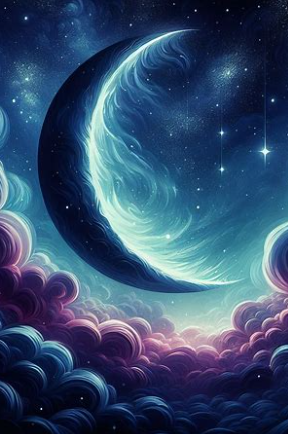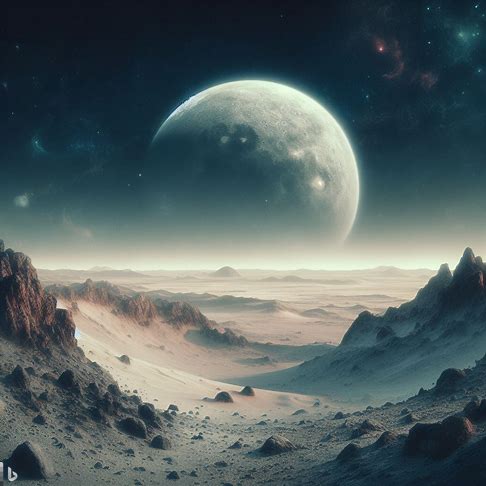|
The moon today . . Moon Phases, EffectsEarth, Composition, and LegendIntroduction The Moon, Earth's only natural satellite, has captivated human imagination for millennia. Serving as a prominent celestial object in the night sky, it has been a source of wonder, fascination, and inspiration for countless generations. This article explores the phases of the Moon, its effect on Earth, its composition, and some of the many legends and myths surrounding this enigmatic celestial body. Phases of the Moon The Moon's phases result from its position in relation to the Earth and the Sun. As the Moon orbits Earth, it appears to change shape, progressing through a series of phases: new moon, crescent, first quarter, gibbous, full moon, and last quarter. These phases occur approximately every 29.5 days, known as a lunar month or synodic month. 1. New Moon: The Moon is directly between the Earth and the Sun, and its illuminated side faces away from Earth, rendering it invisible in the sky. 2. Waxing Crescent: A thin, crescent-shaped sliver of the Moon's illuminated side becomes visible as the Moon moves away from the Sun. 3. First Quarter: Half of the Moon's illuminated side is visible as it continues to move in its orbit. 4. Waxing Gibbous: More than half, but not all, of the illuminated side of the Moon is visible. 5. Full Moon: The entire illuminated side of the Moon faces Earth, appearing as a complete, bright circle in the sky. 6. Waning Gibbous: As the Moon continues in its orbit, less than the entire illuminated side is visible. 7. Last Quarter: Half of the illuminated side is visible once again. 8. Waning Crescent: A thin, crescent-shaped portion of the illuminated side remains visible before the Moon returns to its new moon phase. The Effect of the Moon on Earth The Moon's gravitational pull significantly impacts Earth in various ways: 1. Tides: The most noticeable effect is the ocean tides. The Moon's gravity causes a bulge in Earth's ocean waters, creating high tides. As Earth rotates, the bulge moves, causing the tides to rise and fall. 2. Tidal locking: Earth's gravitational pull affects the Moon as well, causing it to become tidally locked. This means that the Moon rotates on its axis at the same rate as it orbits Earth, resulting in the same side always facing Earth. 3. Stabilization: The Moon's presence helps stabilize Earth's axial tilt, preventing dramatic shifts in climate over long periods. Composition of the Moon The Moon is primarily composed of rock and dust, with its surface dominated by regolith—a layer of fragmented rock, dust, and small particles. Beneath the regolith lies the lunar crust, which is mainly composed of two types of rock: basalt and anorthosite. The lunar mantle, beneath the crust, is thought to be composed of partially molten rock. The Moon has a small, partially molten core consisting mainly of iron, with smaller amounts of sulfur and other elements. Legends of the Moon Throughout human history, the Moon has been a central figure in various myths, legends, and cultural beliefs. Some notable examples include: 1. Selene/Luna: In Greek and Roman mythology, Selene (Greek) and Luna (Roman) were goddesses of the Moon, often depicted riding a silver chariot across the sky. 2. Chang'e: In Chinese mythology, Chang'e is a lunar goddess who accidentally consumed an elixir of immortality, causing her to ascend to the Moon and become its resident. 3. Werewolves: European folklore tells of werewolves, humans who transform into wolf-like creatures during the full moon. This legend has persisted in popular culture and literature, often associated with curses or supernatural phenomena. 4. Moon Rabbit: In many Asian cultures, there's a belief in the Moon Rabbit, a celestial creature that lives on the Moon and is often associated with immortality or the elixir of life. The Moon Rabbit is said to be visible in the patterns formed by the lunar maria. Conclusion The Moon has been a source of wonder and inspiration for humanity since time immemorial. Its phases, effects on Earth, composition, and the myriad legends that have arisen around it provide a fascinating glimpse into the ways in which this celestial body has shaped human history, culture, and our understanding of the cosmos. This article was written in whole or in part by artificial intelligence. The Moon's ComposureThe Moon's composition is primarily rocky and silicate-based, similar to the Earth's crust. Here are the main components of the Moon:
It's important to note that the Moon lacks an atmosphere and has very little water compared to Earth. The absence of a significant atmosphere means there is no weathering or erosion like on Earth, which preserves the lunar surface features in a relatively pristine state. Studying the composition of the Moon provides valuable insights into the early history of our solar system, as the Moon's geological activity has been relatively quiet compared to Earth's. Additionally, lunar exploration, including manned missions and robotic probes, has played a crucial role in expanding our understanding of the Moon's composition and geology. This article was written in whole or in part by artificial intelligence. |
Moon Affects on HumansBirths, Crime , BehaviorIntroduction The Moon has long been a subject of fascination and mystery, and its potential effects on human behavior and natural phenomena have been the subject of countless studies, myths, and legends. This article explores the Moon's potential influence on births, criminal activity, and other aspects of human life, examining the scientific evidence and popular beliefs surrounding these topics. The Moon and Births There is a widespread belief that the full moon influences birth rates, leading to a higher number of deliveries during this lunar phase. The idea stems from the Moon's effect on tides, with some suggesting that its gravitational pull could also affect the amniotic fluid surrounding a baby in the womb. However, scientific studies have not found conclusive evidence to support this theory. A 2005 meta-analysis of 70 studies on lunar phases and birth rates found no consistent correlation between the full moon and an increased number of births. Other studies have similarly failed to establish a definitive link, leading most researchers to conclude that the Moon's phases do not have a significant impact on birth rates. The Moon and Criminal Activity The belief that crime rates increase during a full moon dates back to ancient times and has persisted in popular culture. Known as the "lunar effect" or "Transylvania effect," this phenomenon suggests that the full moon can cause increased aggression and criminal activity. However, research on this topic has produced mixed results. Some studies have found a slight increase in crime rates during full moons, while others have found no correlation or even a decrease in criminal activity. A 2016 study published in the Journal of Criminal Psychology analyzed data from three police departments in the United States and found no relationship between lunar phases and crime rates. The inconsistencies in these findings suggest that the connection between the full moon and criminal activity may be more rooted in cultural beliefs and superstitions than in scientific evidence. The Moon and Other Human Phenomena Aside from births and criminal activity, the Moon has also been associated with other aspects of human behavior and health. Some popular beliefs and anecdotal evidence suggest that the Moon can influence sleep patterns, mood, and even mental health. However, scientific evidence supporting these claims is limited and often contradictory. For example, a 2013 study published in the journal Sleep Medicine found that participants took longer to fall asleep, slept for shorter durations, and experienced reduced sleep quality during the full moon. In contrast, a 2014 study published in Sleep Health found no association between lunar phases and sleep patterns. Similarly, research on the Moon's influence on mood and mental health has yielded mixed results, with some studies suggesting a possible link and others finding no correlation. Overall, the evidence supporting the Moon's impact on human behavior and health remains inconclusive. Conclusion The Moon has captivated human imagination for centuries, and its potential effects on various aspects of human life have been the subject of much speculation and debate. While some studies suggest possible connections between lunar phases and phenomena such as births, criminal activity, and human behavior, the scientific evidence remains inconsistent and inconclusive. Further research is needed to determine whether the Moon's influence on these aspects of human life is genuine or merely a product of cultural beliefs and superstitions. This article was written in whole or in part by artificial intelligence. Monthly MoonsVarious names are given to full moons based on different cultural or traditional naming conventions. Here are some examples:
These names are often rooted in cultural and historical traditions, varying across different cultures and regions. They add a unique and poetic touch to our understanding and appreciation of the lunar cycle. This article was written in whole or in part by artificial intelligence. |
History of
|
Cosmic Reverence:
|
The Moon God: SinSin, also known as Nanna, is the ancient Mesopotamian moon god, and he holds a significant place in the pantheon of Sumerian, Akkadian, and Babylonian cultures. Here are key aspects of the moon god Sin:
This article was written in whole or in part by artificial intelligence. TrothThoth is an ancient Egyptian deity known for his multifaceted roles in mythology, religion, and symbolism. He is one of the most prominent and versatile gods in the Egyptian pantheon, often depicted as a man with the head of an ibis, or sometimes as a baboon. Thoth's significance encompasses various domains, including wisdom, writing, magic, the moon, and the arbitration of disputes. Key Aspects of Thoth:
Thoth's worship was widespread throughout ancient Egypt, and he was venerated in various forms and aspects across different regions and time periods. The city of Hermopolis Magna was particularly dedicated to the worship of Thoth, and it housed a major cult center in his honor. In summary, Thoth is a multifaceted deity in ancient Egyptian mythology, embodying wisdom, writing, magic, and lunar associations. His enduring significance reflects the profound impact he had on the intellectual and spiritual life of ancient Egyptian culture. This article was written in whole or in part by artificial intelligence. Babylonian CalendarThe Babylonian calendar, particularly in its early forms, was a lunisolar calendar, meaning it combined lunar and solar elements to track time. It was used by the ancient Babylonians, who inhabited the region of Mesopotamia, present-day Iraq, and had a significant impact on the development of early astronomy and timekeeping. Here are key features of the Babylonian calendar, especially in its lunar aspects:
While the Babylonian calendar had certain limitations in its attempt to harmonize lunar and solar cycles, it represented an early and significant step in the human quest to organize time, understand celestial phenomena, and create a structured calendar for societal and religious purposes. This article was written in whole or in part by artificial intelligence. |



